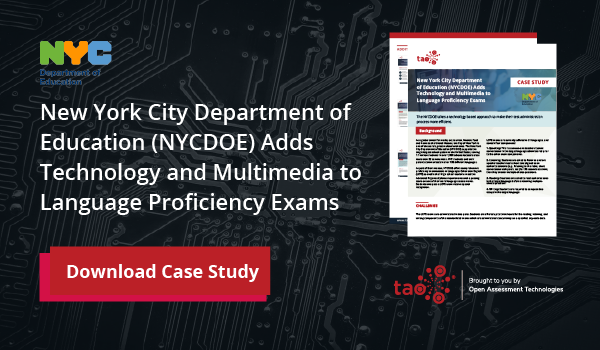High-quality assessments are an essential tool for helping school districts and teachers determine exactly what level their students are at and how much they have grown from year-to-year. Great assessment design doesn’t only consider the content being tested, it also takes into account the developmental level of the students that it is testing.
Designing assessments for young students can prove exceptionally challenging as there is a wide array of developmental levels in students under age 8 due to the rapid rate of growth in a student’s linguistic, motor, and physical skills set. This means that there can be large gaps in non-content related abilities within one classroom which makes it difficult to design assessments that effectively evaluate every student. Technology however, has eased the strain of designing quality assessments considerably and has enabled schools to assess students early on in a less intrusive manner than traditional paper and pencil testing.
Why is it important to start assessing students early in a non-intrusive way?
Assessments are critical for determining whether students are progressing in their learning or not and in determining what is working within a classroom. For young students, these assessments need to be non-intrusive and as stress-free as possible to allow students to demonstrate what they know. Students will likely take some form of state or district-level assessment every year, by providing a positive experience with assessment early on, educators can set students up for long-term success.
Between 25-40% of students in the United States suffer from some form of test anxiety. Much of this anxiety can be traced to poor experiences on early childhood assessments. These early assessments are formative for young people. It is important that teachers, parents, and schools as a whole do not place undue pressure on students and that assessments are designed utilizing Universal Design principles to create a more inclusive test.
What are the challenges of assessing young children?
Early childhood assessment has specific challenges that need to be addressed to ensure that students are being measured on the desired skill or content and not how well they can navigate a testing platform. Some of the biggest challenges in testing young children include:
- Distractions – students under 8 may struggle with distractions during an assessment. For many, they have not been asked to sit and take an independent assessment and it is difficult for them to focus on completing tasks. Creating assessments that are shorter in length is vital to minimizing distractions in young students.
- Motor skill development – unlike older students, many young students may not have the fine motor skills to do things like fill in testing bubbles. Students also may have a wide variety of handwriting skills, making it difficult to answer short response questions on both technology and paper-based assessments.
- Linguistic development – young students are all still mastering their first language and some students are also mastering a second language on top of their first language. This makes developing assessments that evaluate skills and not language ability, difficult to do.
- Defining the purpose – younger students typically do not understand the purpose of taking an assessment. Feeling disconnected from the day-to-day class routine and, in some cases, highly pressured to perform on the assessment, young students may struggle to do their best.
- Equity – developing equitable assessment has always been challenging, and it is no different when assessing young students. Students have different backgrounds and life experiences leading to a variety of strengths and skills, it is important to consider this variety when assessing young students.
How can technology help?
Using online assessment platforms and implementing technology-based assessments can help assess young students in myriad ways, including:
- Reducing distractions – technology-based tests can be taken in shorter chunks and given more frequently, reducing the amount of time in each test session and eliminating distractions, and more engaging than traditional testing
- Suitable for multiple levels of development – unlike traditional paper testing methods, technology-based assessment can be designed to give students information in a variety of ways utilizing multimedia while also allowing students to respond using text, voice, touch screen, or any combination methods. Tech-based testing also allows for multiple languages to be integrated with ease when compared with traditional paper testing.
- Providing many data points – one drawback of paper-based testing is that it is so labor intensive to provide the testing materials to schools which means educators often give just one assessment per year. This is not an effective way of measuring student ability, especially for young students who may be more impacted by day-to-day environmental changes. With tech-based testing, students can be given shorter assessments more frequently giving teachers many data points to take into consideration.
Considerations for choosing the right assessment solution
Choosing the right assessment solution can be difficult and is not to be taken lightly. The right solution will accurately measure what students know and what skills they possess, while the wrong solution can give teachers bad information and lead to wasted time and effort. Some considerations for choosing the right early childhood assessment tool include:
Age Appropriateness
The right assessment solution for young students should allow all students to answer questions and respond with ease. Looking for a system where questions can be answered by all levels of students is a key to ensuring that the students can demonstrate their knowledge and not simply their ability to navigate a testing platform.
It is also important to consider whether the questions can be developed with age-appropriate complexity. This means that students are not overwhelmed by the questions and they can provide their answers without worrying about the method of responding.
Student Engagement
The best assessment solutions allow for greater student engagement and can hold the attention of even the youngest test takers. By incorporating game-like simulation into the assessment students can show their knowledge without it feeling like a classic test. This reduces anxiety and can foster a positive relationship with assessment days.
It is also important to take into account that many students are already playing games and interacting with iPads or tablets before the first day of school even begins. By incorporating games and touch screen technology when possible, students stay engaged and even have fun while being assessed for standards-based skills.
Other considerations
In addition to age appropriateness and student engagement, there are other factors that schools and schools districts need to consider before choosing the right early childhood assessment system, including:
- Flexibility
- Ease of scoring
- Ease of assessment development
- Safety and privacy
- Student interface
—
Assessing young students is essential to determine how well they are progressing and what their overall abilities are. However, there are many things to consider when assessing young students to ensure that students are set up for success down the road and eliminate the negative relationship with testing that many students develop. By ensuring that assessments are age-appropriate, engage students, and accurately measure student abilities, teachers can get the most out of the process.
To understand how technology-based assessment can work for early childhood assessments explore this case study video with the New York City Department of Education to see just how effective technology-based assessment can be for assessing young learners.
Open Assessment Technologies provides online-testing capabilities for schools and school districts, for more information or to get started today contact a sales representative here.


